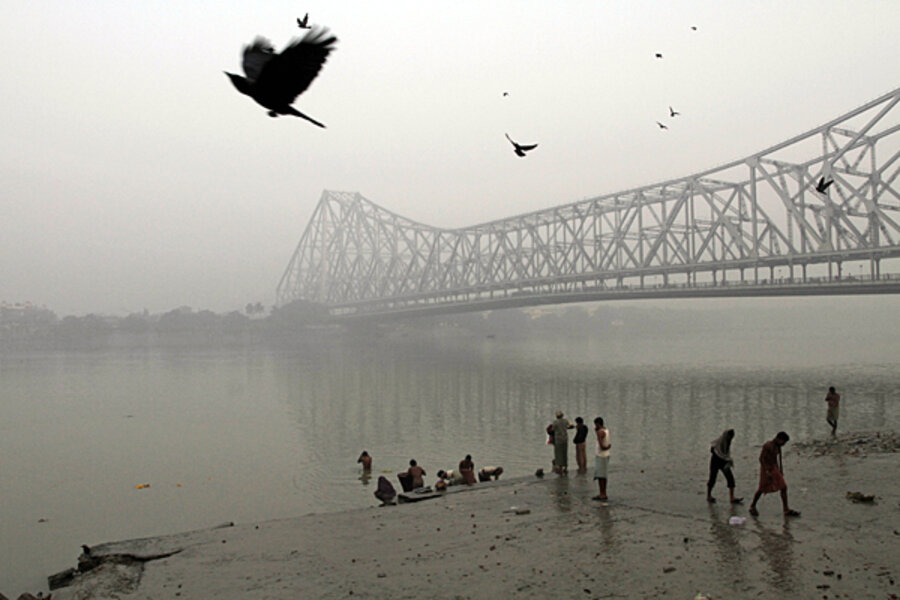Famous bridge in India is in danger of coming down ... because of spit
Loading...
| Kolkata, India
It was first reported in 2010 that the pillars of Kolkata’s landmark Howrah bridge were being used as spittoons by pedestrians who chewed gutkha – a tobacco product popular with millions in India.
Engineers who surveyed the cantilever structure then reported that the struts supporting the girders of the bridge had already lost half of their metal casing: The corrosion was apparently caused by acids in the gutkha.
Soon the Lions Club of Howrah launched a “Save Howrah Bridge from Spit” campaign urging people not to spit on the bridge.
The campaign spread across the city of Kolkata, where reddish-brown gutkha stains are visible almost everywhere — pavements, streets, office staircases, business houses, and residential complexes. Prominent citizens of Kolkata joined the campaign in an effort to rid the city of the ugly stains.
Gutkha is a commercially produced pre-packaged mixture of crushed betel nut, tobacco, lime, paraffin, and other “secret” ingredients, many of which are carcinogenic and addictive.
Some brands of gutkha also contain lead, arsenic, chromium, nickel, and cadmium, which are as bad as nicotine. To make its shelf life longer, magnesium carbonate – which is used in fire extinguishers and is a known carcinogen – is also added to gutkha.
Activists reported about a year ago that one-third of men and one-fifth of women across India are addicted to chewing tobacco and gutkha was its most popular form.
Because of its candy-like flavor and dirt-cheap prices — 4 to 6 cents per sachet — gutkha has become increasingly popular among children, who chew and even eat it. An estimated 5 million of India’s children are addicted to gutkha, and every day another 5,000 try it for the first time, according to reports last year by the American Cancer Society.
Research indicates that tobacco kills 1 million Indians annually and that gutkha alone leads to 80,000 cases of oral cancer every year — the highest incidence in the world. In recent years an anti-gutkha campaign has picked up steam across the country with several nongovernment organizations lobbying for a ban on gutkha.
In August 2011, India’s Food Safety and Standard Authority issued a regulation declaring that no foodstuff, including gutkha, could contain tobacco. Last year some states began following the order by banning gutkha.
With Andhra Pradesh and Odisha states having banned it earlier this month, the manufacture and sale of the product has now been prohibited in 17 of India’s 28 states and 3 of the 7 union territories (UTs), including New Delhi. However, reports in many local newspapers suggest that gutkha is being smuggled from other regions and is still being sold in many states.
Kolkata-based anti-gutkha campaigner Sekharesh Ghoshal said that states and union territories should cooperate and ban the tobacco in the national interest.
“Sachets of gutkha display a warning that it’s dangerous for health. Yet gutkha users do not pay any attention to such health risks and keep on chewing it,” says Dr. Ghoshal.
“Unless gutkha is banned and actually made unavailable in the market, you cannot stop people from using it. A ban only in parts of the country is of no help.”
But in many states the gutkha companies are fighting the ban by taking the local government to court.
They argue that gutkha is a tobacco product that cannot be classified as a foodstuff, and therefore cannot be banned. Still, courts in most states have upheld the ban.
Bela Naskar, the mother of two child addicts in a slum in Kolkata, says she vehemently supports a ban on gutkha.
“My 10- and 13-year-old sons have been into gutkha for some years. They take several sachets of it every day. It’s bad for their health. But they don’t listen to my warnings.”
“We really need a ban on gutkha in our state,” Ms. Naskar says. “Otherwise I shall not be able to rid my children from this dangerous addiction.”





